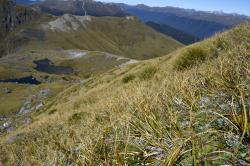- Taxon
- Gallery
Short dark green snow tussock of densely aggregated, compressed, suberect to ± prostrate shoots from a sheath-covered old low-creeping prone stout stem, of 1–2–(3) finely pointed leaves accumulating and weathering in situ. Prophyll broad, shining below, hairy centrally; setae scabrid. Leaf-sheath (3)– 6–10 cm, strongly keeled above, reddish purple below becoming stramineous, persistent, inter-rib hairs minute; margin usually somewhat wavy, short hairy above or not; apical tuft of hair 0.5–1 mm or 0. Ligule narrow, to 0.25 mm. Leaf-blade to 30 cm × 2 mm, prominently keeled below as in leaf-sheath, strongly compressed, becoming flat, 3–5 mm wide, thin and weak, persistent, abaxially glabrous except for prickle-teeth on keel towards long fine twisting apex, adaxially prickle-toothed on nerves, margin with long hairs below and prickle-teeth above or hairs absent. Culm to 35 cm, glabrous, compressed, < leaves; sheath heavily nerved and sometimes empurpled. Inflorescence 6–10 cm, laxly open, pulvinate, of 11–15–20 solitary spikelets on long glabrous drooping branches and pedicels, naked below, occasionally 1–2 hairs below spikelet. Spikelet 8–10 mm long, of 3–4–5 florets, with awns flexed inwards and intercrossing. Glumes unequal, glabrous except for occasional long hairs at base of upper glume, occasionally mucronate, < adjacent lemma lobes; lower to 5 mm, 3–5-nerved, upper to 7 mm, 7-nerved. Lemma (3)–4–6 mm; hairs dense at margin and aside central nerve, scattered and fewer elsewhere though sometimes in all internerves, ≥ sinus; lateral lobes 2–3.5 mm, triangular–acute, or awned to 1.5 mm, apex ciliate; central awn 4 mm flexed inwards from flat or slightly rotating column 0.5–0.75 mm, tip sometimes hooked. Palea (3.5)–4– 5.5 mm, ~ tip of lemma lobes, pointed or shallowly bifid, apex ciliate; keels long ciliate above glabrous below; flanks long hairy below. Callus 0.6–0.75– 1 mm; hairs 2–3 mm. Rachilla 0.5–0.75 mm, glabrous. Lodicules 1.0 mm including hairs to 0.6 mm. Anthers 2.5 mm, empurpled. Gynoecium: ovary 0.75 mm; stigma-style 2.5 mm. Caryopsis to 2– 2.5 mm; embryo 0.75–1.25 mm; hilum 1–1.5 mm.
[Reproduced from Connor & Lloyd (2004, New Zealand J. Bot. 42: 531-536) with permission from The Royal Society of New Zealand.]




